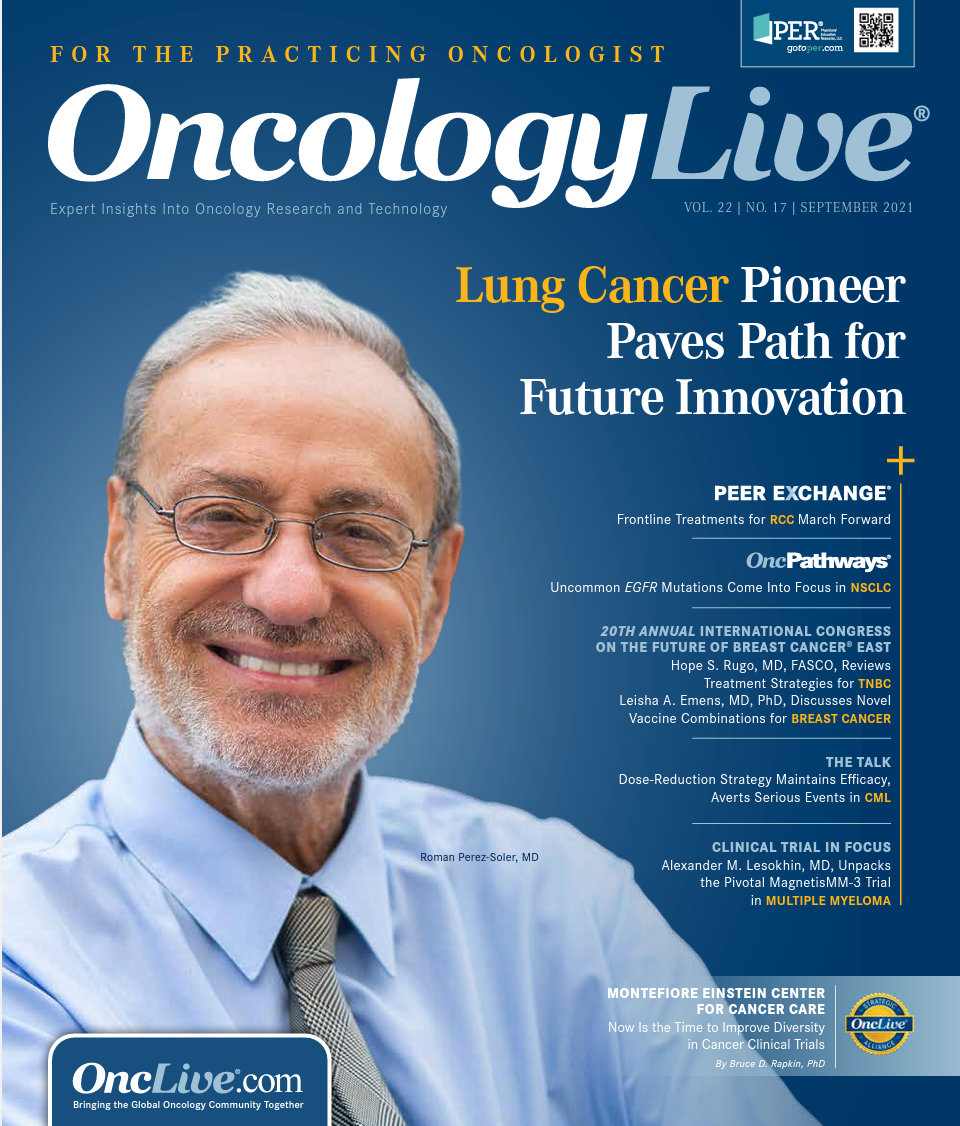Publication
Article
Oncology Live®
Belumosudil Expands Treatment Options for Chronic GVHD
Author(s):
Data from the phase 2 ROCKstar trial demonstrated that belumosudil induced clinically meaningful, durable responses in patients with chronic graft-vs-host disease, irrespective of previous treatment received, severity of disease, and number of organs involved.
Corey S. Cutler, MD, MPH, FRCPC

Data from the phase 2 ROCKstar trial demonstrated that belumosudil induced clinically meaningful, durable responses in patients with chronic graft-vs-host disease, irrespective of previous treatment received, severity of disease, and number of organs involved. Moreover, these findings supported the FDA approval of the agent for use in adult and pediatric patients 12 years and older with chronic GVHD following failure of at least 2 prior lines of systemic therapy.1
The approval of the ROCK2 inhibitor affords investigators another option to fill the treatment void that exists for patients with disease progression following treatment with other available therapies including ibrutinib (Imbruvica) and ruxolitinib (Jakafi).
“Ibrutinib [was] the first approved therapy [for] this disease and was a great step forward for us; [however] it’s not effective in all patients,” said study investigator Corey S. Cutler, MD, MPH, FRCPC, in an interview with OncologyLive®. Cutler is an associate professor of medicine at Harvard Medical School and medical director of the Adult Stem Cell Transplantation Program at Dana-Farber Cancer Institute in Boston, Massachusetts.
“Many patients who initially respond to ibrutinib eventually progress and require later [lines of] therapy. Having more than one option for these patients is really something that our patients need,” he said.
Targeting Rock Elicits Response
ROCK2 inhibition rebalances immune response to treat at the level of the germinal center by downregulating Th17 cells and upregulating regulatory T cells.2 Data from the ROCKstar study showed that patients who received belumosudil achieved a clinically meaningful response across all key subgroups. Investigators for ROCKstar examined the agent in 2 cohorts of patients—200 mg of belumosudil once daily and 200 mg of belumosudil twice daily.
In previously reported data, the response rates between the 2 arms were similar, and the FDA approved the 200-mg once-daily dose. Specifically, 65 patients received belumosudil 200 mg once daily, and overall response rate (ORR) was assessed through day 1 of cycle 7 per ROCKstar protocol.
The ORR was 75% (95% CI, 63%-85%), with 6% being complete responses and 69% being partial responses.1 The median time to first response was 1.8 months (95% CI, 1.0-1.9), with a median duration of response of 1.9 months (95% CI, 1.2-2.9), which was determined as time of first response to progression, death, or new systemic therapies for chronic GVHD. In patients who achieved response (n = 49), 62% did not initiate a new systemic therapy or die for at least 12 months since response.
ORRs stratified by organ involvement, a subgroup analysis of interest, were recently published in Blood.2 The analysis included combined data from the 2 arms of the study (N = 132). In total 75% had involvement in joint/fascia, 10% lower gastrointestinal (GI), 17% upper GI, 55% mouth, 24% esophagus, 74% eyes, 83% skin, 10% liver, and 38% lungs. The ORR was greatest for those with joint/fascia involvement at 71%, with 51% complete responses and 20% partial responses. For patients with lower and upper GI involvement, the ORRs were 69% and 51%, respectively. Further, the ORRs were reported for mouth (55%), esophagus (45%), eyes (42%), skin (37%), liver (39%), and lungs (26%).2,3
Across all study participants, failure-free survival rates at 6 and 12 months were 75% and 56%, respectively.
Future Directions
“[Similar to] any drug in GVHD that we have tested in the past, we tend to use these agents in patients who have very few options left for their therapy,” Cutler said. “The natural thing to think about for the compound—and really any other compound following development—is to look at its activity in earlier stages of chronic GVHD. [This includes] either frontline steroid failures or front line [in combination with] steroids, potentially even frontline [use] instead of steroids. There is always the idea of whether this is an appropriate agent to use for prophylaxis of chronic GVHD or not.”
Cutler noted that investigators are interested in examining the efficacy of the agent in subtypes of GVHD, including patients with fibrosis as one of their prominent features, because ROCK regulates multiple profibrotic processes including myofibroblast activation.2 “There stands to be at least a reasonable chance that this drug can reverse established fibrosis,” he said. “We would also like to see it tested in larger groups of patients with chronic GVHD–induced fibrosis to determine how effective it can be in reversing established fibrosis.”
The updated analysis demonstrated that the efficacy of belumosudil was maintained, regardless of previous treatment with ibrutinib (n = 46) or ruxolitinib (n = 38). The ORRs in the ruxolitinib and ibrutinib subsets were 68% (95% CI, 51%-83%) and 74% (95% CI, 59%-86%), respectively. Although belumosudil represents a treatment option for patients who experience failure of these agents, future head-to-head studies may provide insights to where this agent best fits into the treatment paradigm.
“We would like to see this agent tested earlier in the treatment of patients with chronic GVHD, perhaps in direct comparison to other commonly used agents,” Cutler said. “There still will be a need for other agents in this space. Some patients will not respond to this drug, and others may require a combination of therapies to maximize the likelihood of successful chronic GVHD outcomes.”
References
- FDA approves belumosudil for chronic graft-versus-host disease. FDA. Updated July 16, 2021. Accessed August 16, 2021. bit.ly/3mc5Sbg 2. 3. Cutler CS, Lee S, Arai S, et al.
- Belumosudil for chronic graft-versus-host disease after 2 or more prior lines of therapy: the ROCKstar study (KD025-213). Presented at: European Hematology Association 2021 Virtual Congress; June 7-9, 2021; Accessed August 16, 2021. bit.ly/3y6vzfr
- Cutler CS, Lee SJ, Arai S, et al. Belumosudil for chronic graft-versus-host disease (cGVHD) after 2 or more prior lines of therapy: the ROCKstar study. Blood. Published online July 15, 2021. doi:10.1182/blood.2021012021





















%20(2)%201-Recovered-Recovered-Recovered-Recovered-Recovered-Recovered-Recovered-Recovered-Recovered-Recovered-Recovered-Recovered-Recovered-Recovered-Recovered-Recovered-Recovered.jpg?fit=crop&auto=format)
%20(2)%201-Recovered-Recovered-Recovered-Recovered-Recovered-Recovered-Recovered-Recovered-Recovered-Recovered-Recovered-Recovered-Recovered-Recovered-Recovered-Recovered-Recovered.jpg?fit=crop&auto=format)
